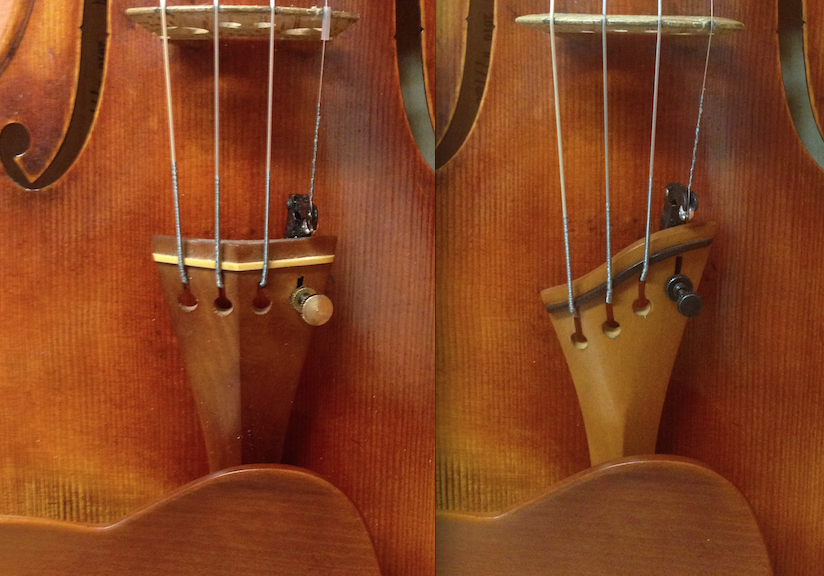|
Tailpieces have a large impact on the sound that is produced by an instrument. The tailpiece connects the strings to the button or end pin on the bottom of the instrument. Besides just holding the strings down and possibly creating a spot for a fine tuner the tailpiece can change how an instrument plays. Depending on where the tailpiece is set the instruments responsiveness, tone, resonance, and projection will be effected. Part of the tailpiece's power on the instrument's tone has to do with quality and weight of the material used. Tailpieces are commonly made from ebony, boxwood, or rosewood. many companies are now making tailpieces out of other materials ranging from plastic, to special metal alloys. This is to help reduce weight while still being able to resonate well. Although harp style tailpieces have been around for centuries they are just recently gaining a large following in the violin community. Harp style tailpieces are curved so the afterlength of the string (the amount of string that reaches from the bridge to the tailpiece) ends up being longer on the G-string side. This change in afterlength is a third factor in the tailpiece's effect on the tone of the instrument. Frirsz Music is one of the largest makers of harp tailpieces for violins. According to their site a harp tailpiece (or more specifically a Frirsz tailpiece) will:
The tailpiece that was installed on the violin used for this comparison is not a Frirsz brand but is a harp style made from a good quality boxwood. This tailpiece compared to the Hill style that was previously on my violin is much lighter. After a few days of playing with it there was without a doubt a difference in the tone produced.
Clarity & Sensitivity The strings that were used in this comparison are the new Spirit! strings from Thomastik-Infeld. With the harp tailpiece the strings responded faster than they did with the Hill style tailpiece. It was not a dramatic change but I did feel that with the harp tailpiece I had more control over the attack and nuance of each note. Projection & Balance this is very mixed. The projection on the E-string side was GREATLY increased. I could not believe the volume I was achieving from the E-string, especially in the higher positions. As I moved to the lower strings the sound progressively diminished. The G-string ended up being dramatically quieter compared to the sound when using the Hill tailpiece. The string set became far from balanced. When string companies set out to make a balanced set they are most likely are using a typical tailpiece (like a French or Hill style) when testing them out. One could always find a new string combination of strings with a stronger low end that would complement the high end. The harp tailpieces may create more balance in the downward force put upon the bridge, but on my violin there was less balance in the tone. Since the harp tailpiece creates a different environment than what the strings are designed for it doesn't seem that it would "balance" the set unless they were unbalanced in the first place. Richness & Resonance Here is where the harp tailpiece shines. There is definitely more richness and overtones to the notes that were not there with the Hill tailpiece. This is especially true for the G and D-Strings. Wolf Tones There were no wolf tones on my violin to begin with so I cannot say if a harp tailpiece will significantly reduce or eliminate wolf tones. The idea makes sense and I would not doubt that using a harp tailpiece would have a positive effect on getting rid of, or at least changing the prominence of wolf tones. Conclusion The harp tail piece that was used on my violin created more resonant/richer tones, faster response, and greater projection on the higher end. The tradeoff was a lack of projection on the lower end and loss of balance in the set. If your instrument already feels balanced or you enjoy using a complete set put together by the manufacturer then a harp tailpiece may not be for you. If your instrument needs a boost in the upper end or enjoy experimenting with different string combinations then a harp tailpiece may be the best thing for your instrument. A harp style tailpiece is not a perfect fit for every instrument and I do not believe that it will take over as the dominant tailpiece used on violins anytime soon. Since more companies are now producing them making the price dramatically drop a harp style tailpiece is definitely worth a look, but keep your old one close by.
6 Comments
7/26/2014 05:48:34 am
I agree with your conclusions. Wore a Wittner tailpiece made of composite, which was far lighter, recently changed by a harp tailpiece of Pernambuco (Brazil Wood), and do not know if the wood is, but the sound was warmer too. The response, and the absence of wheezing sound, was the most surpriendeu me.
Reply
Shawn Boucké - Violin String Review
7/26/2014 10:30:31 am
Thank you. We are looking at doing a rosin review, but not of the gold yet. If this first one goes over well that one will definitely be on the list.
Reply
Joshua
4/8/2016 09:54:38 pm
Hello, I recently discovered a harp tailpiece with built in fine tuners. I am an intermediate violinist. Do you think that this is better than the one you reviewed? Would I be better of getting this one? http://www.ebay.com/itm/272166942355
Reply
Shawn (ViolinStringReview)
4/8/2016 10:31:31 pm
Often tailpieces with those fine tuners are easy to break and hard to fix. The tone change has more to do with the string length change than the specific tail piece. Also, with the price I don't know how the quality of the wood is. As far as being better or worse I cannot say for sure but am leaning towards not better. I feel the harp shape is more of a novelty thing and although might help create a specific tone may just make many instruments feel unbalanced.
Reply
Joshua
6/17/2016 04:06:17 am
I ordered a Rosewood Harp tailpiece from Dov Schmidt. And I hated it just like you disliked your boxwood one. So, I contacted him and he recommended that I replace the tailcord with a kevlar tailcord. And to my surprise, it worked! It really brought out the G and D strings and it balanced everything out overall. I think you should test this.
Edward Torgerson
6/17/2019 07:46:13 am
I am an orchestral and chamber multi-instrumentalist (happens when you were a composition major in your youth.) On all four instruments (vn, va, vc, cb) for me, the primary reason for the harp tailpiece is the quality of sound in the low strings in the upper positions. Many instruments choke up there, but the harp lets me get a fatter and bigger sound in the upper positions than I would get on the adjacent string.
Reply
Your comment will be posted after it is approved.
Leave a Reply. |
Spotlight ReviewsPrevious Spotlight Reviews
Product Reviews Coruss Synthetic Bow Hair Leatherwood Bespoke Rosin iPhone Tuners Magic Rosin Standard vs. Harp Tailpiece Electric Violin Comparison String Reviews NEW Fiddlerman Strings Vision Strings (Thomastic-Infeld) Kaplan Viola Amo/Vivo/Forza Fiddlerman Strings Jargar Superior Amber Viola (Warchal) Alphayue (Thomastik-Infeld) Evah Pirazzi Gold (Pirastro) Capriccio Soloist (Dogal) Cantiga (Corelli) Charm (For-Tune) Avantgarde A (Warchal) Russian Style A (Warchal) Kaplan Amo & Vivo (D'Addario) Spirit! (Thomastik-Infeld) Brilliant (Warchal) Sensicore (Super-Sensitive) Red Label Pearl (Super-Sensitive) Pro-Arté (D'Addario) Original/Standard (Larsen) Virtuoso (Larsen) Tzigane (Larsen) Amber - Full Set (Warchal) Amber - Forte E (Warchal) |
Contact | About | Terms & Rules
Like us on Facebook to stay informed on news, reviews, and giveaways!
Like us on Facebook to stay informed on news, reviews, and giveaways!
Sponsors



